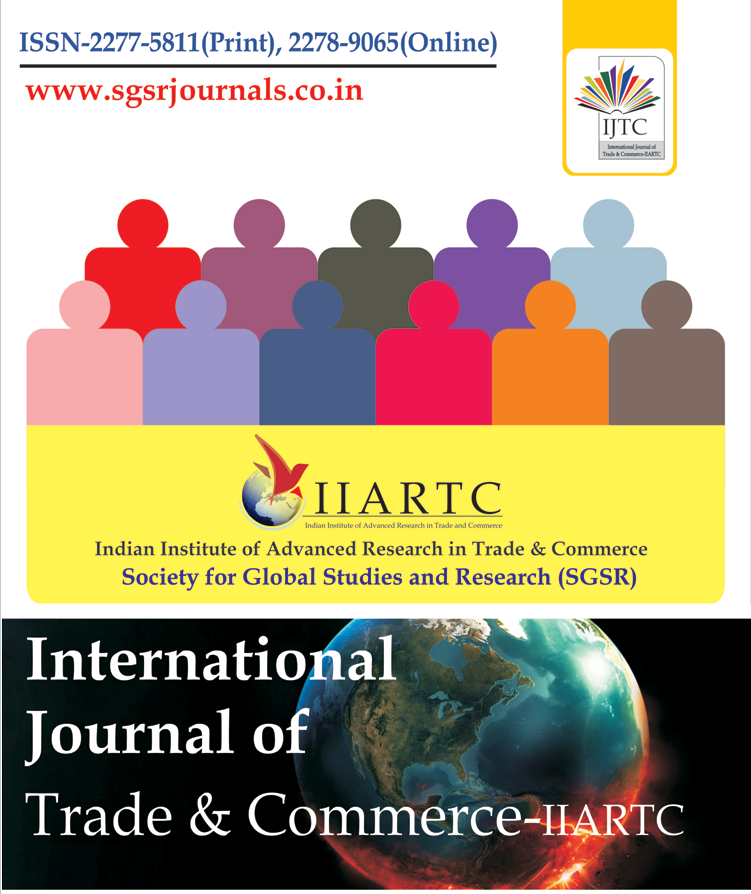Home ⇨ International Journal of Trade & Commerce-IIARTC

International Journal of Trade & Commerce-IIARTC
Impact Factor (IF):5.135 (COSMOS), IF:7.249 (ISRA), IF:3.721 (ISI)
ISSN:2277-5811 (P), ISSN:2278-9065 (O)
Frequency: Half Yearly
A Study on Employees’ Perception on Quality of Work Life and Job Satisfaction in manufacturing organization – an Empirical study
Quality of Work Life (QWL) is being used these days by organizations as a strategic tool to attract and retain the talent. QWL policies are increasingly becoming part of the business strategies and focus is on the potential of these policies to influence employees? quality of working life and more importantly to help them maintain work-life balance with equal attention on performance and commitment at work. QWL is “The degree to which members of a work organization are able to satisfy important personnel needs through their experience in the organization” The aim of this study is to find out about the employee’s perception on their work-life quality. Previous studies indicated that employees’ perception on work life quality significantly influenced their job satisfaction. 460 employees were participated in this study. However, only 251 survey questionnaires were returned yielding 54.6% response rate. Ten variables to measure Quality Work Life (QWL) are examined namely support from organization, work-family conflict, relationship with peers, self competence, impact on job, meaningfulness of job, optimism on organizational change, autonomy, access to resources and time control. All these variables are tested the relationship with job satisfaction. The test indicated that each of the QWL variables on its own is a salient predictor of Job Satisfaction. However, 7 QWL variables are no longer significant predictors for job satisfaction when all the 10 QWL variables are entered into the regression equation. Using multiple linear regressions, only 3 QWL variables (meaningfulness of job, optimism on organizational change and autonomy) are significantly related to Job Satisfaction. However, they only explained 28.8% of the variance in Job Satisfaction, F (10, 240) = 11.134, p<.05.
Author:D. Chitraa*, V.Mahalakshmib
Abstract:Quality of Work Life (QWL) is being used these days by organizations as a strategic tool to attract and retain the talent. QWL policies are increasingly becoming part of the business strategies and focus is on the potential of these policies to influence employees? quality of working life and more importantly to help them maintain work-life balance with equal attention on performance and commitment at work. QWL is “The degree to which members of a work organization are able to satisfy important personnel needs through their experience in the organization” The aim of this study is to find out about the employee’s perception on their work-life quality. Previous studies indicated that employees’ perception on work life quality significantly influenced their job satisfaction. 460 employees were participated in this study. However, only 251 survey questionnaires were returned yielding 54.6% response rate. Ten variables to measure Quality Work Life (QWL) are examined namely support from organization, work-family conflict, relationship with peers, self competence, impact on job, meaningfulness of job, optimism on organizational change, autonomy, access to resources and time control. All these variables are tested the relationship with job satisfaction. The test indicated that each of the QWL variables on its own is a salient predictor of Job Satisfaction. However, 7 QWL variables are no longer significant predictors for job satisfaction when all the 10 QWL variables are entered into the regression equation. Using multiple linear regressions, only 3 QWL variables (meaningfulness of job, optimism on organizational change and autonomy) are significantly related to Job Satisfaction. However, they only explained 28.8% of the variance in Job Satisfaction, F (10, 240) = 11.134, p<.05.




